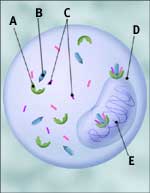
|
Cell with estrogen receptors, estrogen, and helper
proteins.
A Estrogen receptor
B Estrogen
C Estrogen helper proteins
D nucleus
E DNA genetic material |
|
Hormone Receptors in Breast Cancer
Most breast cancer cells (especially in postmenopausal
aged women) will still be sensitive to the effects of estrogen or progesterone, which can be
measured by the pathologist and reported as having positive estrogen or
progesterone
receptors.
A common misconception among women is that this somehow 'proves' that hormones caused
their cancer. In truth a positive hormone receptor test is a good thing for two reasons:
better prognosis and sensitivity to hormone therapy.
Better prognosis: since all cancer start with a normal cell that goes bad... the closer
the cell looks like a normal cell (well differentiated) or acts like a normal cell (a
normal breast cell responds to hormones. e.g. in pregnancy the breast get larger)... the
less serious the cancer (the less mutated or dangerous.) So the prognosis for women with
estrogen receptor cancer is much better than women who have receptor negative cancer.
Compare the survival by tumor size and number of nodes in early cases and you will see
that survival is much better for hormone + cases...go
here. Also
in cases of advanced, metastatic breast cancer, the survival is longer in cases that are
hormone +...go here. There are estrogen receptors (ERP) and
progesterone (PgR) and best survival is if both are positive (sensitive) and
worst if both are negative (go here).
Sensitivity to hormone therapy. If the cancer shows positive hormone receptors then the
cancer is quite likely to respond to treatment with hormone therapy drugs (e.g. Tamoxifen
or Arimidex, see hormone
therapy.) |
